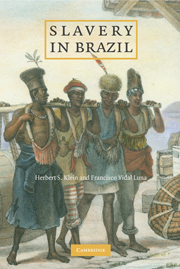10 - Transition from Slavery to Freedom
Published online by Cambridge University Press: 05 June 2012
Summary
Two events marked the transition from slavery to freedom in Brazil. The first was the definitive ending of the Atlantic slave trade in 1850. The second was the rise of abolitionism in Europe and America, which eventually doomed the institution in every Western society. The ending of the slave trade had an immediate impact on Brazil in that it marked the peak of the slave population and heralded its progressive decline. The overall negative growth rate of the imperial slave population continued unabated, and although it would not have led to the disappearance of the slave labor force, it did reduce it systematically from its 1850 peak. From the census of 1872 to slave matrícula of 1887, the total population of slaves had declined by 780,000 persons or 52 percent compared to its 1.5 million size in 1872. Even in the prosperous Southeastern coffee zones, the slave population declined by a quarter from 1872, whereas in the Northeastern region and the far Southern provinces the decline was even more dramatic (see Table 10.1).
In turn, the secular increase in slave prices led to a slow reorientation of slave population distribution. As can be seen both in a longer term series of nominal prime slave prices in Minas Gerais and in a comparison with Rio de Janeiro slave prices in the post-1850 period, there was both a high correlation between prices in these two zones and a secular rise in slave prices during this period as an immediate response to the ending of the trade.
- Type
- Chapter
- Information
- Slavery in Brazil , pp. 295 - 320Publisher: Cambridge University PressPrint publication year: 2009

